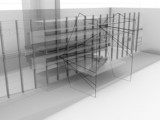Supervisors:
2008
The building of TATE Modern in London, a work of the architects Herzog & De Meuron as a museum of modern art, is used as the base for the investigation of the structured space and the experience that one gains inside it.
The inner façade of TATE Modern, the “screen wall” with the bay windows motivated the need for a new meaning of the “depth of the surface” concept and the re-determination of the inner façade. This inner façade is a “live” element that constantly provokes the “reconstruction” of the building’s images. We claim that the depth of the surface is perceived through the gradual conversion of the two-dimensional into a three-dimensional space, which is in fact a conversion of the front sight to a diagonal look. This conversion is combined with the degrees of privacy of the spaces that surrounds it and the change of the scale’s impression.
Crucial boundaries are tracked down and set the boundaries from vertical levels. Between these boundaries there are intermediate spaces, the “extended thresholds”. The transition time from one boundary to another is connected to the gathering of spatial information, as well as with contraction and release, since the segmental spatial concept is substituted by a sudden disclosure of the “whole”.
Focusing on “screen wall” with the bay windows and their hybrid character, we can see how an architectural element contributes to the design of the whole building, and how the general design gives characteristics and qualities to its divided elements.
Bay windows function as converters of the two-dimensional space to a three-dimensional one, giving depth to the surface of the “screen wall” depending on the movement or the position of the human body and look.
In general, the management of a boundary and the depth of the surface of this boyndary can function as a synthetic tool and factor for creating complicated relationships among the divided spaces of a building, the general volume of a building and of its surrounded space. The divided elements that constitute the surface can give information for the building itself, re-determine and give meaning again to its spaces, enhancing the visitor’s experience even more.
In every case, the human body through its movement and behavior is the medium for the activation of the meaning of the architectural space.
